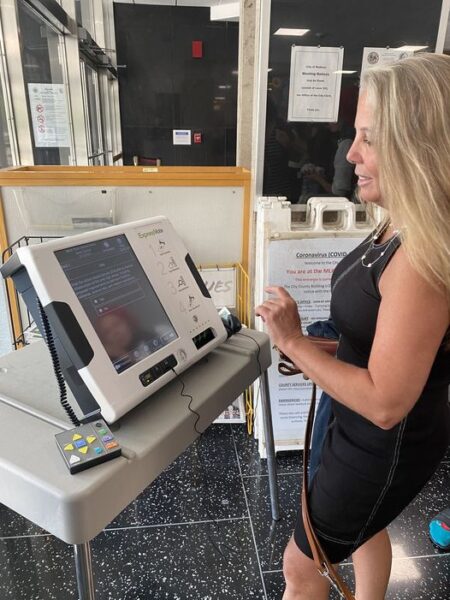
Voters with disabilities are casting ballots in increasing numbers. According to researchers at Rutgers University, nearly 18 million voters with disabilities voted in 2020, up from 16 million in 2016. People with vision loss vote in higher numbers than do voters with other disabilities. That said, due to systemic barriers and recent changes in election laws, voting is more complicated than ever before for many people with disabilities.
That’s why it’s important for voters with vision loss to have a voting plan in place to make sure your vote is cast on time and counted.
Upcoming Elections
These are the dates of 2024 elections in Wisconsin:
- February 20, Spring Primary. This election is for local, nonpartisan offices with three or more candidates running. These races are for positions like circuit court judge, alderperson, etc.
- April 2, Spring and Presidential Preference Election. This is where runoffs from those February primaries will be settled and local races that did not require a primary will take place. This is also the Presidential Primary that will help decide which candidate each party will nominate.
- August 13, Partisan Primary. Voters will determine a general election Republican candidate running for U.S. Senate against incumbent Tammy Baldwin. This election will also determine general election candidates for seats in the state legislature and U.S. House of Representatives.
- November 5, General Election Day. Voters decide who will be the next President. The general election will also determine who will be elected to Congress and the State Legislature.
So, there’s lots of voting ahead. The time to make that voting plan is now. To get started, here are a couple of extremely useful websites:
- The Wisconsin Elections Commission’s My Vote Wisconsin website is one of the most important resources. This is where you can, among many other things, register to vote, request an absentee ballot, and to see what is on your ballot for each election. Important note: To register on the My Vote website, you must upload a photo of your I.D., so if you will need assistance, make sure to have a friend or family member available.
- Another terrific resource is the Wisconsin Disability Vote Coalition website. The site provides, among other things, a 2024 Voter Toolkit, a Resources for Voters with Disabilities fact sheet, and a Make your Plan to Vote fact sheet.
So what are the elements of a sound voting plan?
Voter Registration
You can’t vote if you’re not registered. There are several ways to register. All of them require proof of address. Some examples of proof of address include a utility bill; current and valid driver’s license or state identification card; residential lease; or an affidavit from a social service agency if homeless. You can find a more complete list on the Madison City Clerk’s Office website.
Here’s where you can go to register:
Online at MyVote.WI.gov
At the front desk of a municipal agency, like a library. NOTE: This registration must be made at least 20 days before an election.
By mail. Registration forms are available in English, Spanish and Hmong. Download and print the application from the above My Vote site. Fill it out and mail it to your Clerk’s office at least 20 days before Election Day. You will need to include proof of address.
In-person absentee voting begins two weeks before election day. It ends the Sunday before the election. You can determine absentee voting locations by calling your town or city clerk’s office. Remember to bring your proof of address info.
At the polls on Election Day. Though registering early will save you some time at the polls on Election Day, you may register at your polling place when you go there to vote. Again, bring proof of address and photo ID (driver’s license or state I.D. card).
Make sure your I.D. is up to date! This is important to check and, if necessary, act on right away. You’ll need a transportation plan to the Department of Motor Vehicle office. Be sure to check the hours of operation for the office near you, since some locations have limited hours.
Once registered, you can vote in advance in person by absentee ballot two weeks prior to the election at a location designated by your local town or city clerk. To vote absentee by mail, go to your local town or city clerk’s office or obtain a ballot through the My Vote site.
Voting by Mail: Important Things to Keep in Mind
- The last day to request an absentee ballot is five days before an election.
- You can return your absentee ballot request form through the mail or in person at your local elections office.
- Ballots must be received by Election Day.
- You will need an adult to witness your absentee ballot envelope to have it counted. Your witness can also be your assistor in completing the ballot!
- The witness’s address must be listed on the absentee ballot envelope.
You can track the status of your absentee ballot once mailed or dropped off on the My Vote website.
Voting in Person on Election Day
- Be sure to have a transportation plan for getting to and from the polls. Have a back-up plan in place too. Weather and other unexpected situations might affect your plan.
- Once at the polls, you have the right to an accessible voting machine. You also have the right to an assistor of your choosing. Examples of who your assistor can be include a poll worker, a family member, a friend or a neighbor. The only people who can’t assist you are your employer, a union representative, or a candidate on the ballot.
- Problems at the polls? Report it to a clerk on location. Also report the problem to the Disability Rights Wisconsin Voter Hotline at 1-800-DIS-VOTE.
- It’s also important to report any voting accessibility concerns to the Wisconsin Elections Commission using the special form on their website.

